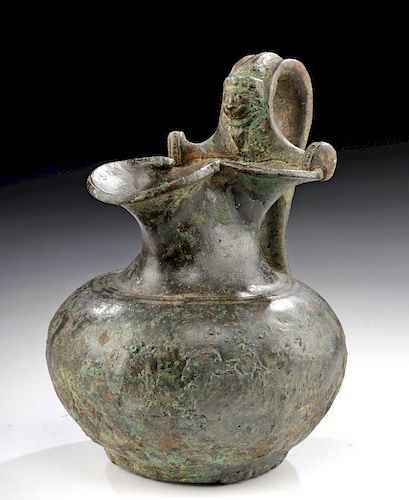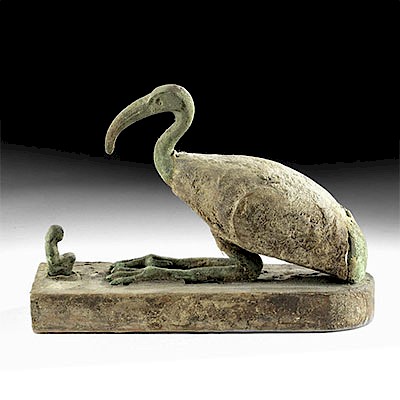Roman Bronze Trefoil Oinochoe w/ Lion & Minerva
Lot 68a
About Seller
Artemis Fine Arts
686 S Taylor Ave, Ste 106
Louisville, CO 80027
United States
Selling antiquities, ancient and ethnographic art online since 1993, Artemis Gallery specializes in Classical Antiquities (Egyptian, Greek, Roman, Near Eastern), Asian, Pre-Columbian, African / Tribal / Oceanographic art. Our extensive inventory includes pottery, stone, metal, wood, glass and textil...Read more
Estimate:
$2,500 - $3,500
Absentee vs Live bid
Two ways to bid:
- Leave a max absentee bid and the platform will bid on your behalf up to your maximum bid during the live auction.
- Bid live during the auction and your bids will be submitted real-time to the auctioneer.
Bid Increments
| Price | Bid Increment |
|---|---|
| $0 | $25 |
| $300 | $50 |
| $1,000 | $100 |
| $2,000 | $250 |
| $5,000 | $500 |
| $10,000 | $1,000 |
| $20,000 | $2,500 |
| $50,000 | $5,000 |
| $100,000 | $10,000 |
| $200,000 | $20,000 |
About Auction
By Artemis Fine Arts
Oct 31, 2019
Set Reminder
2019-10-31 10:00:00
2019-10-31 10:00:00
America/New_York
Bidsquare
Bidsquare : Fine Antiquities, Asian, Ethnographic Art
https://www.bidsquare.com/auctions/artemis-gallery/fine-antiquities-asian-ethnographic-art-4581
Our Halloween Day auction features classical antiquities, ancient and ethnographic art from cultures encompassing the globe, plus fine art. Artemis Fine Arts info@artemisfinearts.com
Our Halloween Day auction features classical antiquities, ancient and ethnographic art from cultures encompassing the globe, plus fine art. Artemis Fine Arts info@artemisfinearts.com
- Lot Description
Roman, early Imperial Period, ca. 1st century CE. A beautiful cast-bronze oinochoe (pouring vessel) with a protruding circular foot, a spherical body with lightly impressed rings surrounding the shoulder, a tapered neck, a large rim with a trefoil-style spout, and an ornate handle arching between rim and midsection. The handle features a segmented circular medallion on the laterally projecting arms, a stylized lion head with a thick snout and a shaggy mane on the front, a bifurcated trail coursing towards the lower terminal, and the delicate visage of Minerva on the bottom. Beautiful mottled patina in hues of green, brown, and orange have formed across the composition and imbue it with a handsome presentation evocative of ancient Rome! Size: 4.875" W x 6.6" H (12.4 cm x 16.8 cm).
In the classical world, lions symbolized power, wealth, and might. They were famously featured in many ancient myths, perhaps the most famous being that of Hercules (Greek Herakles) slaying the Nemean lion for his first labor. The lion's fur was believed to be impenetrable to attacks since according to legend it was made of gold and its claws were far sharper than swords with the power to slice through armor. In the end, Hercules defeated the lion by strangling it and wore its skin.
Lions were also favorite iconography for buildings, coins, and statues. Examples include the Lion Gate to the Citadel of Mycenae, the Terrace of the Lions on the island of Delos, and the lion hunt mosaic from Pella featuring Alexander engaged in a lion hunt. Of course lions were also used in the Roman arenas where they would fight other animals, such as tigers and bears.
Regarded as the daughter of Jupiter, from whose head she purportedly was born, Minerva was initially worshipped in Rome as one of the Capitoline Triad along with Jupiter and Juno. At first, she was revered as the goddess of handicrafts, poetry, and the arts in general. Over time, Minerva's stature grew within the Roman pantheon and she became the most important focus of the Quinquatrus festival, which previously had been the domain of Mars, whose amorous affections she famously refused. The five-day festival began on March 19th marking the beginning of the Roman army's campaign season. Minerva also became associated with the concept of victory, as illustrated by Pompey's dedication of a temple to her following his successful campaigns in the east. Similarly, Emperor Domitian claimed the goddess as his protectress and in the second half of the 1st century CE commissioned a temple to her in the Nerva Forum in Rome.
A strikingly similar example, of a slightly larger size, hammered for $6,462 at Christie's, New York "Antiquities" auction (sale 9540, December 7, 2000, lot 583).
Provenance: private New York, New York, USA collection; ex-Artemis Gallery, 2014; ex-private Sarkisian collection, Denver, Colorado, USA, acquired between 1950 and 1965
All items legal to buy/sell under U.S. Statute covering cultural patrimony Code 2600, CHAPTER 14, and are guaranteed to be as described or your money back.
A Certificate of Authenticity will accompany all winning bids.
We ship worldwide and handle all shipping in-house for your convenience.
#149702Repairs to several areas of body, with light restoration, resurfacing, and overpainting along new material and break lines. Handle likely reattached to body and rim, but difficult to discern when. Abrasions and minor indentations to foot, body, and spout, with softening to some finer details on handle, and light encrustations. Light earthen deposits and wonderful patina throughout.Condition
- Shipping Info
-
All shipping is handled in-house for your convenience. Your invoice from Artemis Gallery will include shipping calculation instructions. If in doubt, please inquire BEFORE bidding for estimated shipping costs for individual items.
-
- Buyer's Premium



 EUR
EUR CAD
CAD AUD
AUD GBP
GBP MXN
MXN HKD
HKD CNY
CNY MYR
MYR SEK
SEK SGD
SGD CHF
CHF THB
THB
















